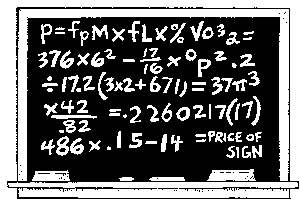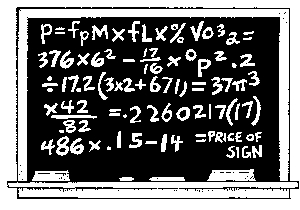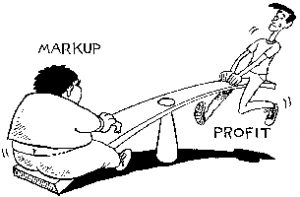Business Management
Pricing Principles
Establishing effective prices requires market savvy and flexibility
Published
18 years agoon

As a sign professional, controlling your destiny is closely linked to the prices your company charges for products and services. Despite a large demand for pricing guidelines, the successful entrepreneurs who ought to be writing these books typically guard their techniques as proprietary. Considering the importance of pricing in business success, it’s surprising that more published data is not available on the subject.
This dearth of information might explain why most sign-specific discussions of pricing and profitability represent one of two extreme views. The optimist’s version of pricing holds that every sign company is capable of earning fat profits by "skimming the cream." According to this outlook, most sign professionals work too hard for too little profit. This line of thought leads toward a promised land where, supposedly, everyone is rich.
On the opposite end of the scale is the "poor-mouth" version of pricing. In this dreary view, the sign business is a world of cutthroat competitors selling signs from the backs of old pickup trucks. Customers are also viewed as chiselers who don’t care about anything except the bottom line. These narratives typically conclude with gloomy observations that price-cutting is ruining the industry.
Approximately midway between these extremes resides the real American sign industry. It’s a trade that continues to grow steadily, providing income for increasing numbers of hard-working people and their families. Like other domestic industries, the sign business is top-heavy, with approximately 20 percent of the largest sign companies accounting for 80 percent of annual sales. Scrambling for the remainder of this market, hundreds of small operators face tough pricing tests on nearly every job. Regardless of a company’s size, however, neither rosy bromides nor despair can help the sign professional develop a pricing strategy that works.
Pricing basis
Because the majority of sign companies are small enough to be considered "mom-and-pop" businesses (less than $1 million annual sales volume), informal pricing based on rough cost estimates and personal intuition is common. While many operators succeed with this method, it’s not as accurate as having a definite formula. Also, without a pricing formula, it’s difficult to forecast future profits, or to make meaningful comparisons of profits on similar jobs.
Conventional business practices have established three general pricing strategies, each with a different orientation. Cost-based pricing is predicated solely on a company’s expenses to manufacture or resell products, and to provide services. A standard markup is added to the cost of materials and labor. Markup percentages vary substantially according to the specific product or service.
Customer-based pricing derives from detailed marketing studies that reveal the purchasing habits of specific customer types. This market research enables a company to target prices for specific groups of consumers. Customer-based pricing is more typical of large firms that sell consumer products and services. Experience has proven that this is an extremely effective pricing method.
Competition-based pricing is a response to competitors’ pricing. A new business, or an existing firm entering a new market, may initially reduce prices to gain a foothold. This strategy, however, involves more than mere price-cutting. To compete successfully without sacrificing profits, it’s essential to gather reliable information about your competition.
Cost and markup
Whether or not you’re using cost-based pricing, it’s important for your company to cost every job. All direct and indirect expenses must be recorded for each project. To calculate the total cost of producing a product or service, use the following formula: Material Cost + Labor Cost + Overhead = Total Cost
In addition to the cost of materials (including shipping and delivery charges), most sign companies incur labor costs to fabricate, install and maintain signs. The total cost of each job must include the cost of all labor required to complete the project. This information should be taken directly from employees’ daily time cards and should include the cost of all employee benefits.
For example, if your shop fabricates a double-faced, electric sign with pan faces, include all labor costs to fabricate the faces (if applicable), create and apply the graphics, and assemble the sign cabinet. If your price includes installation, add the appropriate labor and equipment costs.
Overhead includes all job-related costs other than materials and labor. Operating costs like rent, mortgage interest, utilities, insurance premiums and real estate taxes should be prorated and included in the prices of your products and services.
People starting their first business venture commonly make the mistake of equating business earnings with wages. They base their prices on the amount of income they would like to earn, forgetting about covering overhead costs and earning profits. These operators soon discover that overhead costs are taking a bite out of their projected income. Thus, some of the so-called "chiselers" in the sign business are actually people with good intentions, but faulty pricing schemes.
Because markup percentage ordinarily is a matter of individual choice, it’s probably the most widely debated pricing subject. Don’t be fooled by the bluster. Divorced from the contexts of specific business operations, comparisons of markup percentages are meaningless.
For example, John boasts that he applies a 100 percent markup (sometimes called "keystone pricing") to everything he sells. But John’s firm has a lower sales volume, higher costs for materials, and higher overhead expenses than Jim’s company, which applies only a 60 percent markup. Examining the two firms’ net profits, it’s obvious that John’s higher markup doesn’t make him smarter or more successful than Jim.
Most markups on materials range from 50-100 percent, but they are sometimes out of this range. In the sign business, some examples of high-markup items are wire nuts, bolts and paint. The per-unit prices of these items are so low that it’s not uncommon for prices to reflect markups of 500 percent or more.
Low-markup items are usually those with the selling price restricted by certain factors. For example, a sign company might be required to submit copies of subcontractor invoices with its own invoicing. If the customer is aware of the subcontractor’s price, he will probably resent paying more than a 20 percent markup for "handling." A second example is products used so frequently that the wholesale prices are well known to the customer. It’s not uncommon for large, corporate customers to dictate vendors’ allowable markups for certain items.
Labor costs are commonly marked up 200-250 percent. This is necessary to cover labor-related administrative costs, the costs of FICA taxes and other expenses. The owner’s salary, which typically includes time spent for bookkeeping, calling on clients and other business-related activities, may also be included in the hourly labor charge on a prorated basis.
For example, suppose that the owner establishes his annual salary at $50,000. He might divide this salary by the number of working days in a year (approximately 250), yielding a $200 cost for each workday. If the owner handles all administrative and office functions, and employs five shop workers, he divides $200 by the total number of man hours that the company reports each workday (5 employees @ 8 hrs. each per day = 40 hrs. per day). Thus, to cover the cost of his salary, the owner adds $5 per hr. to the marked-up hourly cost of labor (40 hrs. per day x $5 = $200).
Profits and competition
To sustain business growth, it’s not enough to meet expenses and mark-up your materials and labor. Your business must earn consistent profits to finance expansion; and this profit must be built into your pricing as indicated by the following formula: Materials + Overhead + Labor, (including all Markups) + Profit = Price
What constitutes a reasonable profit percentage? Although no hard and fast rules apply, manufacturing businesses have traditionally added profits equal to 20-30 percent of their products’ total costs (labor + materials + overhead). For services, a 10-20 percent profit margin is more typical. Because profit margin is closely related to price, the business owner’s judgment is critical in maximizing revenues. The best pricing strategy is one that’s flexible enough to take profits when possible, or to trim profits when necessary to meet competition.
Once you know your costs and set your markups, your company can establish price lists based on these factors. When you put new prices into effect, however, problems may arise. If your prices are above the competition, customers complain and sales drop. Conversely, if sales are strong but profits are low, you may need to increase your prices.
Here we encounter the "starving sign man syndrome." When a business owner believes that price-cutting is the sole means to attract customers, he soon discovers that his company is doing a lot of work for little or no profit. If you feel trapped on this no-growth treadmill, upgrade your pricing. This problem sometimes arises when a business neglects to increase its prices annually. If you don’t adjust prices regularly, inflation eats up your profits.
Investigate your competitors’ prices and calculate some averages. If you need to cut your prices to meet competition, you must know how much you can afford to cut. By doing some research on your competitors’ prices, you might be able to determine approximately how much you need to cut — or whether pursuing the business is worthwhile.
Smell the coffee
While many sign companies can benefit from improved pricing strategies, price is only one element in business success. Obviously, your company must back up its pricing with high-quality products and services. Because you can also improve profits by subtraction, a continuous effort to reduce materials costs and improve production efficiency is vital.
Typically, owners who consistently charge premium prices enjoy certain special advantages that are not available to most operators. For example, if someone is a highly skilled maker of hand-carved or gilded signs, he might command high prices and have a long waiting list of projects. Similarly, if an entrepreneur enjoys advantages, like an exclusive contract, a superb location or special manufacturing equipment, he might also command premium prices. Also, if a company is introducing a new type of product, it might employ "skim pricing" to maximize profits during the early phase of the product’s life cycle. In each case, high prices are functions of non-competitive environments.
Reading between the lines of ST‘s ‘1997 State of the Industry Report’, however, it’s clear that "skimming" certainly isn’t the sign-business norm. With the widespead availability of computer-aided sign-making (CAS) equipment, the typical business environment is characterized by stiff competition among a large number of similarly qualified competitors. In this arena, effective pricing is crucial to a company’s long-term survival. If your competition is really chiseling on price, they probably won’t survive long enough to seriously threaten your market share. Poorly conceived pricing is the fastest way for a company to get itself in trouble. That’s why, as early as possible in the sign-business game, it’s advisable to place your company’s pricing strategy on a firm, logical foundation.

SPONSORED VIDEO
Introducing the Sign Industry Podcast
The Sign Industry Podcast is a platform for every sign person out there — from the old-timers who bent neon and hand-lettered boats to those venturing into new technologies — we want to get their stories out for everyone to hear. Come join us and listen to stories, learn tricks or techniques, and get insights of what’s to come. We are the world’s second oldest profession. The folks who started the world’s oldest profession needed a sign.
You may like

NUtec Digital Ink Invests in Solar Energy for Facility

5 Reasons to Sell a Sign Company Plus 6 Options

21 Larry Albright Plasma Globes, Crackle Tubes and More
Subscribe

Bulletins
Get the most important news and business ideas from Signs of the Times magazine's news bulletin.
Most Popular
-

 Tip Sheet2 weeks ago
Tip Sheet2 weeks agoAlways Brand Yourself and Wear Fewer Hats — Two of April’s Sign Tips
-

 Photo Gallery3 days ago
Photo Gallery3 days ago30 Snapshots of the 2024 ISA Sign Expo
-

 Ask Signs of the Times5 days ago
Ask Signs of the Times5 days agoWhy Are Signs from Canva so Overloaded and Similar?
-

 Real Deal2 weeks ago
Real Deal2 weeks agoA Woman Sign Company Owner Confronts a Sexist Wholesaler
-

 Paula Fargo22 hours ago
Paula Fargo22 hours ago5 Reasons to Sell a Sign Company Plus 6 Options
-

 Benchmarks1 week ago
Benchmarks1 week ago6 Sports Venue Signs Deserving a Standing Ovation
-

 Photo Gallery22 hours ago
Photo Gallery22 hours ago21 Larry Albright Plasma Globes, Crackle Tubes and More
-

 Women in Signs2 weeks ago
Women in Signs2 weeks ago2024 Women in Signs: Megan Bradley














